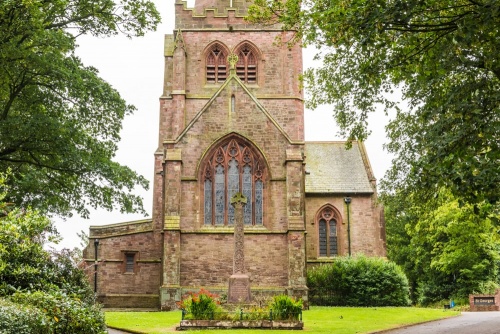
There are two historic churches in the Cumbria town of Millom. The first, and much older building, is Holy Trinity, located not in the village itself but well to the north by Castle Farm and the ruins of Millom Castle. Holy Trinity was built in the 12th century and boasts several late-medieval tombs.
History
The parish church of St George, by contrast, stands in the centre of Millon, off St George's Road. By the late Victorian period, Millom was growing larger and had moved away from its ancient centre, leaving Holy Trinity stranded a mile to the north. A new church was needed to serve the growing population.
St George's Church was built from 1874-87 by Edward Graham Paley and Hubert James Austin of Lancaster, who were responsible for many 19th-century churches and country houses throughout the north of England.

Like most of Paley and Austin's churches, St George's is designed in Gothic Revival style, inspired by 14th-century ecclesiastical architecture. The church is built of sandstone with ashlar dressings under a slate roof. The design is simple, with a nave and north aisle, chancel, south vestry, north transept and central tower.
There are several very good Victorian stained glass windows including one installed in 1911 in memory of Cedric Vaughan, the Chairman of the Hodbarrow Mining Company.
Look for a poignant wall plaque in memory of Charles Hornung of the 18th Battalion Royal Fusiliers. Hornung died in action on 7 February 1916 at just 18 years and 9 months of age. He had that very morning received his papers for an officer's commission.

Norman Nicholson's Grave
Norman Nicholson, OBE was a poet, essayist, critic, novelist, and playwright, but it is for his poetry that he is most remembered. Nicholson wrote of local concerns, of the changes he saw in his Cumbrian home. His prose is simple and direct, using vernacular speech that connected to his northern roots.
He wrote poems on themes that affected his home region, from mining, ironwork, and quarrying, to religion and faith. His works weave traditional patterns of speech together in an accessible way. Nicholson was published by TS Eliot, who worked with the Faber and Faber publishing company.
Norman Cornthwaite Nicholson was born in Millom in 1914 and died in Whitehaven in 1987. He spent his whole life in the area apart from two years in a sanitarium while he was recovering from tuberculosis. His birthplace on nearby St George's Terrace is marked with a blue plaque. Nicholson regularly worshipped in George's Church.

To reach his grave you have to go out the church door, turn left and follow the churchyard path past the west end of the building, turn right around the fence, then follow the path into the overflow graveyard. Turn right and you will find the grave of Nicholson and his wife Yvonne (d 1982) in the row of gravestones nearest the fence. Inside the church, there is a handy leaflet with a map showing the route to Nicholson's grave.
The gravestone bears three lines from 'Sea to the West' (1981) reading,
'Let our eyes at the last be blinded
Not by the dark
But by the dazzle'

Nicholson is also remembered by a colourful stained glass window in the church, designed by Christine Boyce and installed in 1900. The window is painted with symbols drawn from Nicholson's poems and referencing sites near Millon such as Hodbarrow and Black Combe.
You can learn more about Norman Nicholson's life and writings at the Heritage Centre on Station Road.
Outside the east end of the church is a war memorial in the shape of a Celtic cross, decorated with traditional Celtic interlace patterns. You might assume that the cross commemorates the dead of WWI, but you'd be wrong; it was erected in 1900 to commemorate the local men who fought and died in the Boer War.

St George's Church is an interesting late Victorian building, most notable for its links to Norman Nicholson.
Getting There
The church is located on the south side of St George's Road, just east of its junction with Station Road. The church was open when we visited and as far as we can determine it is usually open to visitors.
About Millom, St George's Church
Address: St George's Road,
Millom,
Cumbria,
England, LA18 4JE
Attraction Type: Historic Church
Location: On the south side of St George's Road just east of the railway station.
Website: Millom, St George's Church
Location
map
OS: SD171799
Photo Credit: David Ross and Britain Express
NEARBY HISTORIC ATTRACTIONS
Heritage Rated from 1- 5 (low to exceptional) on historic interest
Millom Discovery Centre - 0.1 miles (Museum) ![]()
Swinside Stone Circle - 4.9 miles (Prehistoric Site) ![]()
Dalton Castle - 5 miles (Castle) ![]()
Dalton-in-Furness, St Mary's Church - 5.1 miles (Historic Church) ![]()
Broughton-in-Furness, St Mary's Church - 5.2 miles (Historic Church) ![]()
Duddon Iron Furnace - 5.4 miles (Historic Building) ![]()
Furness Abbey - 5.9 miles (Abbey) ![]()
Bow Bridge - 6.2 miles (Historic Building) ![]()
Nearest Holiday Cottages to Millom, St George's Church:
More self catering near Millom, St George's Church











